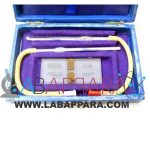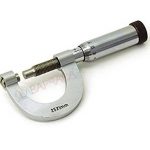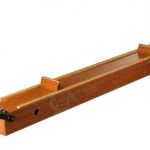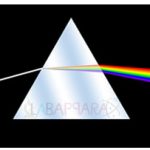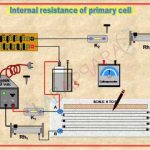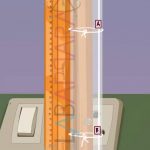physics Equipments
Showing all 12 results
Force constant of a helical spring by plotting a graph between load and extension.
Helical spring: Objective To find the force constant of a helical spring by plotting a graph between load and extension. Theory What is a helical spring? The helical spring, is the most commonly used mechanical spring in which a wire is wrapped in a coil that resembles a screw thread. It can be designed to … Continue reading “Force constant of a helical spring by plotting a graph between load and extension.”
Haemocytometer
Haemocytometer The ( Haemocytometer or counting chamber) is a specimen slide which is used to determine the concentration of cells in a liquid sample. It consists of 2 pipettes, one for red blood corpuscles and the other for white blood corpuscles, and a Counting Chamber with double Neubauer ruling, in a case. The Counting Chamber is made from … Continue reading “Haemocytometer”
Our objective is to use the screw gauge
Screw Gauge: Our Objective Our objective is to use the screw gauge; To measure the diameter of the given lead shot. To measure the diameter of a given wire and find its volume. To measure the thickness of a given glass plate and find its volume. To measure the volume of an irregular lamina. The … Continue reading “Our objective is to use the screw gauge”
Rain Gauge
Rain Gauge – Physics Laboratory Equipment Constructed from copper. It has funnel, an inner receiving vessel and an outer body all of copper, and a glass measuring cylinder. The set of rain gauge is provided with metal case having removeable lid to collect rainfall and a plastic calibrated rain gauge jar duly marked in centimeters. … Continue reading “Rain Gauge”
Sonometer Experiment
Objective To study the relation between frequency and length of a given wire under constant tension using sonometer. To plot a graph between ν and l. To study the relation between length of a given wire and tension for constant frequency using sonometer. To plot a graph between l2 and T. Theory What is a … Continue reading “Sonometer Experiment”
Spectrometer- Prism
Spectrometer- Prism Our Objective: (i) To study the angle of deviation (d) with angle of incidence (i) and to find the angle of minimum deviation (D) from i-d curve. (ii) To find the refractive index of the material of the prism using A and D. The Theory: Prism A prism is an optical element. It … Continue reading “Spectrometer- Prism”
To compare the emfs of two given primary cells using a potentiometer.
The potentiometer- Comparison of emf: Theory Potentiometer Potentiometer is a device used to compare the e.m.f. (electromotive force) of two cells, to measure the internal resistance of a cell, and potential difference across a resistor. It consists of a long wire of uniform cross-sectional area and of 10 m in length. The material of wire … Continue reading “To compare the emfs of two given primary cells using a potentiometer.”
To determine the coefficient of viscosity of a given viscous liquid by measuring terminal velocity of a given spherical body.
Viscosity of a liquid – Stoke’s method: Objective To determine the coefficient of viscosity of a given viscous liquid by measuring terminal velocity of a given spherical body. Theory How do you define viscosity? Viscosity is the property of a fluid by virtue of which an internal resistance comes into play when the liquid is … Continue reading “To determine the coefficient of viscosity of a given viscous liquid by measuring terminal velocity of a given spherical body.”
To draw the reverse characteristic curve of a Zener diode and to find its reverse breakdown voltage.
To draw the reverse characteristic curve of a Zener diode and to find its reverse breakdown voltage. Our Objective To draw the reverse characteristic curve of a Zener diode and to find its reverse breakdown voltage. The Theory: Zener diode A Zener diode is a heavily doped silicon crystal diode which allows current to flow … Continue reading “To draw the reverse characteristic curve of a Zener diode and to find its reverse breakdown voltage.”
To study the relationship between force of limiting friction
To study the relationship between force of limiting friction Objective To study the relationship between force of limiting friction and normal reaction. To find the co-efficient of friction between a block and a horizontal surface. Theory When one body makes an attempt to slide over another body, an opposing force called the force of friction … Continue reading “To study the relationship between force of limiting friction”
To study the static characteristic of a transistor (Common Emitter Configuration)
Transistor characteristics: Our Objective: To study the static characteristic of a transistor (Common Emitter Configuration) The Theory: A transistor is a semiconductor device used to amplify or switch electronic signals and electrical power. It is composed of semiconductor material with at least three terminals for connection to an external circuit. A voltage or current applied … Continue reading “To study the static characteristic of a transistor (Common Emitter Configuration)”
To study the variation in volume with pressure for a sample of air at constant temperature by plotting graphs between P and V, and between P and 1/V.
Boyle’s Law: Objective To study the variation in volume with pressure for a sample of air at constant temperature by plotting graphs between P and V, and between P and 1/V. Theory Properties of gases and Gas laws Gaseous state is a state of matter in which the substance does not have any specific shape … Continue reading “To study the variation in volume with pressure for a sample of air at constant temperature by plotting graphs between P and V, and between P and 1/V.”


